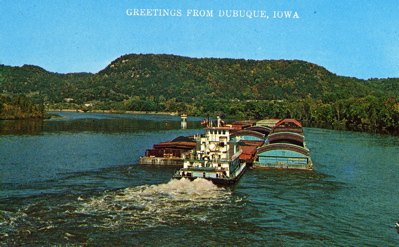Encyclopedia Dubuque
"Encyclopedia Dubuque is the online authority for all things Dubuque, written by the people who know the city best.”
Marshall Cohen—researcher and producer, CNN
Affiliated with the Local History Network of the State Historical Society of Iowa, and the Iowa Museum Association.
BARGE TRAFFIC
BARGE TRAFFIC. Barge traffic has a long history on the MISSISSIPPI RIVER dating back the Northwest Ordinance of 1787 in which Congress guaranteed open barge traffic on the Mississippi. The firm of Archer Daniels Midland (ARM) in 1990 operated a fleet of barges through the American River Transportation Co. (ARTCO) with terminals in Dubuque and McGregor, Iowa and Cassville and Prairie du Chien, Wisconsin. Barges in Dubuque usually carry grain; coal; sand and gravel; fly ash; cement; motor fuels; and salt. A mistaken idea holds that a group of boats tied together is a barge. Each "boat" is actually a barge. Line boats push the linked barges up and down the river while switch boats break up the tows to deliver barges to terminals for loading and unloading. (1)
Barges are used for bulk items since the cost of hauling goods by barge is very low. In 1990 there were times of the year when Dubuque area farmers could save up to 50% getting their grain to market compared to other means of transportation. (2) In 1989 INTERSTATE POWER COMPANY unloaded 940 barges of coal at its three plants. Wisconsin Power & Light Company burned an estimated 330 barge loads of coal annually. Representatives of both company reported barge traffic being significantly lower than rail transportation saving consumers a great deal of money. (2)
A typical barge measures 195 by 35 feet (59.4 m × 10.6 m), and can carry up to 1,500 tons of cargo. Extremely large objects are normally shipped in sections and assembled on site, but shipping an assembled unit reduced costs and avoided reliance on construction labor at the delivery site.
Self-propelled barges may be used when traveling downstream or upstream in placid waters. They are operated as an unpowered barge, with the assistance of a tugboat, when traveling upstream in faster waters.
In 1990 the U. S. Fish and Wildlife Service was negotiating a land swap with ARTCO and NEWT MARINE SERVICE so that the two companies would own barge fleeting sites they have historically used on Pearl Island, south of the JULIEN DUBUQUE BRIDGE and Catfish Island. The sites were appraised at $230,000. The Wildlife service asked the companies to acquire undeveloped industrial-style land of the same value, an estimated 500 acres, to add to the refuge. The fleet sites, appraised for their industrial value, included from between six to ten acres. The Catfish Island fleeting area alone could hold an estimated 100 barges.(2)
In 1922 the announcement was made that barge line operation between Minneapolis and St. Louis was in the near future. W. P. Trickett, vice-president of the combined Upper Mississippi Waterways and the Mississippi Valley associations remarked that development of the upper MISSISSIPPI RIVER was also part of the government program. At the present time, the government operates a barge line between St. Louis and the Gulf of Mexico. With the completion of the line to Minneapolis, increased river traffic was expected. Trickett announced plans for a conference of city representatives along the upper river for outlining a campaign and increasing association membership. While the entire state of Iowa was expected to enjoy benefits of this improvement in river traffic, cities along the river were expected to see the most.
On June 9, 2008 fifteen fully loaded barges struck the JULIEN DUBUQUE BRIDGE. Ten of the barges were full of corn, four with soybeans, and one with iron ore. The bridge was closed to traffic until June 10th when Iowa Department of Transportation officials inspected the bridge and found no serious damage to the structure.
---
Source:
1. Pritchard, Ken, "Barge Traffic a Boon to Tri-State Economy," Telegraph Herald, May 6, 1990, p. 1
2. Ibid., p. 3


